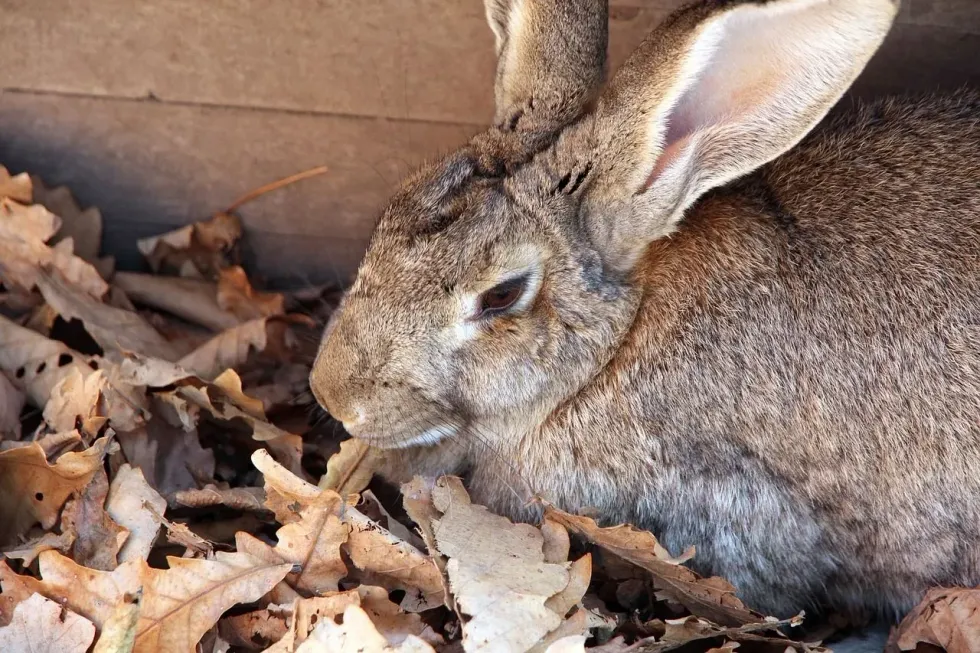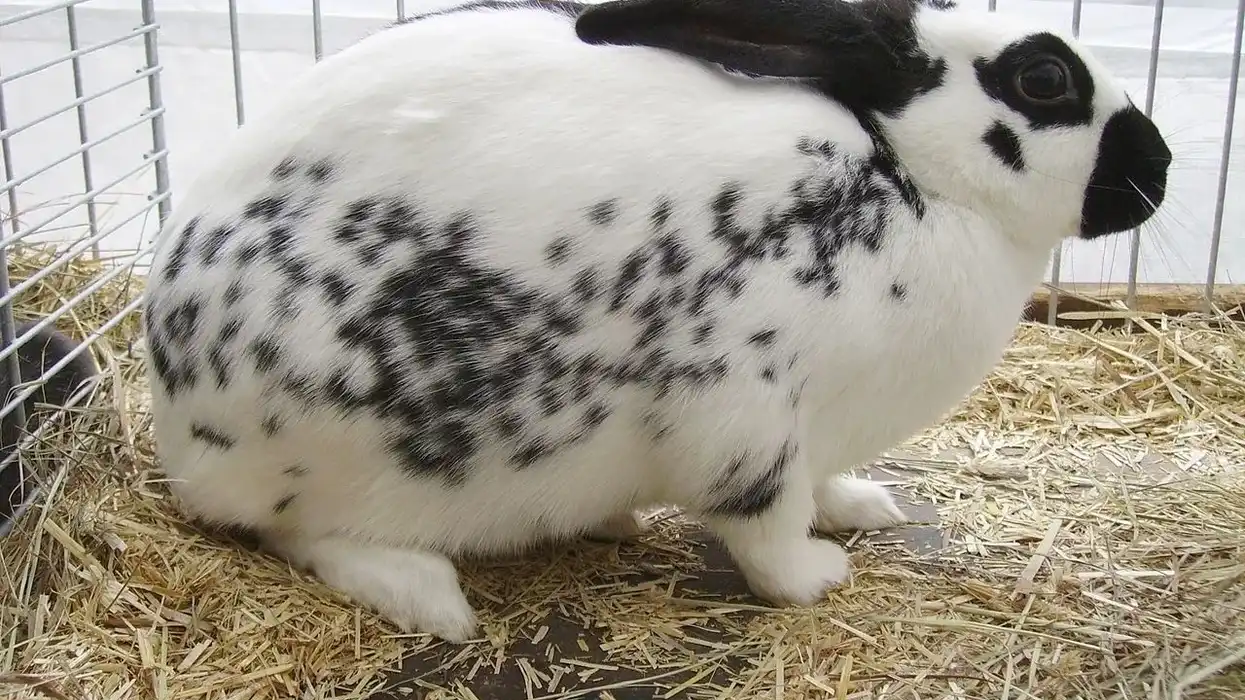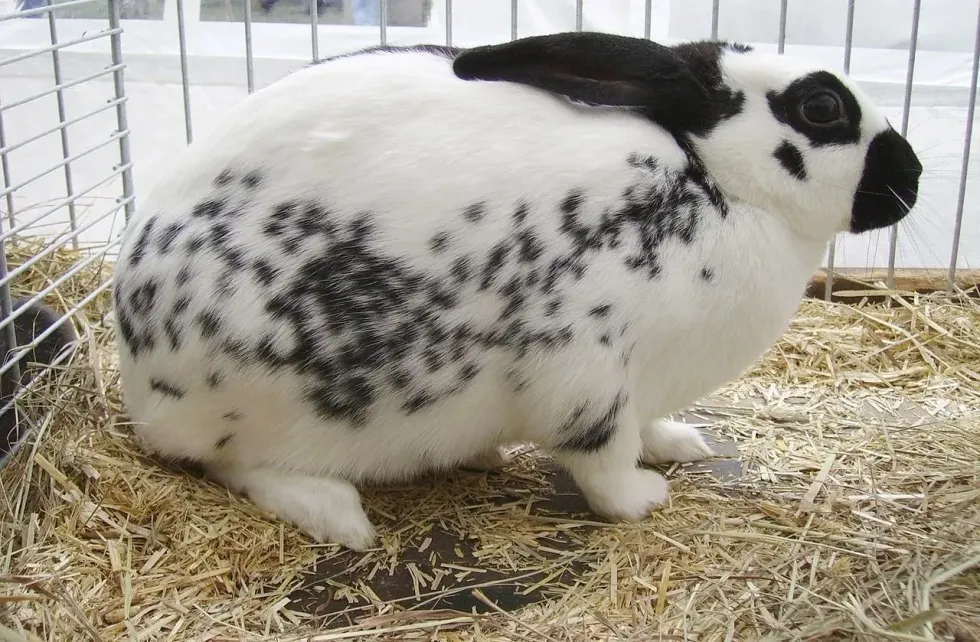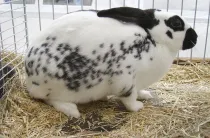Fun Cool Checkered Giant Rabbit Facts For Kids

As evident from its name, the Checkered Giant rabbit is one of the largest rabbit breeds with a muscular build, white coat, and characteristic black markings. In addition, these spotted rabbits have a butterfly-shaped marking on their noses, cheek flashes, solid-colored broad ears on a wide head, and colored rings around their eyes that are usually black.
The Checkered Giant breed of rabbit is recognized by the American Rabbit Breeders Association and is believed to have originated in France.
Another story of the origin of the Checkered Giant rabbit breed dates back to 1904 when Mr. Otto Reinhardt of Germany is said to have crossbred the Great German spotted rabbit with the black Flemish giant rabbit to produce the Checkered Giant rabbit breed.
Either way, the Checkered Giant rabbit breed was first created by breeding together spotted rabbits, French Lops, and Flemish giants. Many breeders followed in the footsteps of Mr. Reinhardt, and soon the Checkered Giant rabbit became popular all throughout Europe.
By 1910, Checkered Giant rabbits made their way into the United States as well.
Read on for more fun and interesting facts about the Checkered Giant rabbit! You may also like to read facts about the Cuban Solenodon and the greater bilby.
Checkered Giant Rabbit Interesting Facts
What type of animal is a Checkered Giant rabbit?
The Checkered Giant rabbit is a domestic breed of rabbit believed to have originated as a result of crossbreeding the black Flemish giant and the Great German spotted rabbit.
What class of animal does a Checkered Giant rabbit belong to?
Like most other wild rabbits, the Checkered Giant rabbit belongs to the class of mammals.
How many Checkered Giant rabbits are there in the world?
The exact population size of the Checkered Giant rabbit is not known. However, being a domestic breed of rabbits, it is safe to consider that their population is in abundance.
Where does a Checkered Giant rabbit live?
Checkered Giant rabbits are mostly kept on farms by breeders. As pets, these rabbits can be kept either indoors or outdoors.
What is a Checkered Giant rabbit's habitat?
Given their size, Giant Checkered rabbits require a large cage or enclosure that allows ample space for the animal to move around freely. The cage should have dimensions of at least 3 x 3 x 4 ft (91 x 91 x 122 cm), with enough room at the bottom of the cage for the rabbit to stretch out.
The cage should be made of wire and it should have a solid bottom covered with hay for the rabbit's safety and comfort.
If the cage or enclosure is kept outdoors, it should be adequately protected against the rain and the sun. It is preferable to bring the rabbits indoors when outdoor temperatures get too high.
Who does a Checkered Giant rabbit live with?
The Checkered Giant rabbit breed usually has a friendly and gentle temperament and gets along well with other household pets. However, the compatibility may differ from pet to pet.
This rabbit breed is not as needy or cuddly as other rabbit breeds, but they do enjoy human interaction and attention even when used for show purposes or breeding.
These rabbits do well with both small and large families as long as they are healthy and have a large space without movement restrictions. Families with young children should be careful with this Checkered Giant rabbit breed since the rabbit's sheer size and weight may mean that children can drop them easily and injure the animal.
How long does a Checkered Giant rabbit live?
The Checkered Giant rabbit breed has a lifespan in the range of five to eight years. Some captive individuals may live up to 10 years as well.
How do they reproduce?
The Checkered Giant breed of rabbits is mostly bred for show. A breeder should ideally wait for the adult female Checkered Giant rabbit to reach the senior weight range (at least seven months old) before considering it for breeding purposes.
Like all other rabbits, Checkered Giant rabbits are capable of producing large litters of about one to 14 offspring per litter. The gestation period for the Checkered Giant rabbit breed is 28-31 days.
Female Checkered Giant rabbits that become receptive to mating will show typical behaviors such as restlessness, rubbing their chin against anything they find, and a desire to mingle with their own kind. However, the utmost care should be taken before breeding Checkered Giant rabbits to avoid poor fertility and the risk of health issues.
The female rabbit should be in good health and should not be already nursing at the time of mating.
What is their conservation status?
Since the Checkered Giant rabbit is one of the domestic rabbit breeds, they are Not Evaluated in the International Union for Conservation of Nature's (IUCN) Red List of Threatened Species. Being a domestic breed, their global numbers are in abundance.
Checkered Giant Rabbit Fun Facts
What do Checkered Giant rabbits look like?
Checkered Giant rabbits are a large-sized rabbit breed with soft, thick, and short to medium-length fur, a wide head, and broad ears. The body is slender but with a muscular build and long, powerful legs.
This rabbit breed has a slightly arched body that is higher off the ground compared to other large breeds of rabbits. The arched stance gives it a resemblance to hares. Checkered Giants are larger than giant chinchillas and Flemish giants, two of the most popular domestic rabbit breeds.
The American Rabbit Breeders Association recognizes only two varieties of Checkered Giant rabbits: white with black markings (the black variety) and white with gray markings (the blue variety).
Further, Checkered Giant rabbits that conform to the Association's standards have a straight dorsal line running along the back from the ears right up to the tail, specific spot patterns on the sides of the body, solid color ears, cheek spots, rings around the eyes, and the distinctive butterfly-shaped mark circling the nose.

*The image below is of the Flemish giant rabbit, not the Checkered Giant rabbit. If you have an image of a Checkered Giant rabbit, please let us know at hello@kidadl.com.
How cute are they?
Like all other rabbits, the Checkered Giant rabbit breed is not just cute but extremely beautiful with its mosaic of colored markings against its milky white fur. The butterfly pattern circling the nose specifically makes this rabbit breed adorable and cute.
How do they communicate?
Most rabbits have complicated body language, and the Checkered Giant rabbit breed is no exception. It may take quite a while for the breeder or owner to fully understand the rabbit's signals.
For instance, a soft grinding of this rabbit's teeth indicates contentment, and loud grinding usually means that the rabbit is in discomfort or pain. Stomping on the ground with the hind leg may mean annoyance.
The rabbit will usually rub its chin on objects when it is receptive to mating or when it is scent marking its territory with secretions from the scent glands on the chin. A relaxed or frightened rabbit will usually lie flat, and it may take experienced eyes to figure out if the animal is scared or simply relaxing.
In addition to these visual cues, vocal signals by a rabbit may include soft squeals or whimpers, grunts, growls, snorts, hisses, oinks, and screams.
How big is a Checkered Giant rabbit?
Individuals of the Checkered Giant rabbit breed can grow up to 25 in (63.5 cm) long and 30 in (76.2 cm) tall. The body length of this breed is almost similar to that of Flemish giant rabbits.
How fast can a Checkered Giant rabbit move?
While the running speed of the Checkered Giant rabbit is not available, one of its parent breeds, the Flemish giant rabbit, can run at a maximum speed of 45 mph (72 kph).
How much does a Checkered Giant rabbit weigh?
The American Rabbit Breeders Association does not specify the maximum weight of the Checkered Giant breed of rabbits.
However, according to the Association's standards, a senior male Checkered Giant rabbit should have a minimum body weight of 12 lb (5.4 kg), and a senior female Checkered Giant rabbit should have a minimum body weight of 11 lb (5 kg), making them much larger than European rabbits.
What are their male and female names of the species?
Female Checkered Giant rabbits are called does and male Checkered Giant rabbits are called bucks.
What would you call a baby Checkered Giant rabbit?
A baby Checkered Giant rabbit would be called a kitten.
What do they eat?
Checkered Giant rabbits should be mostly fed good quality hay along with fruits, vegetables, or food pellets. Fresh water must always be available near these animals.
At least 70% of the rabbit's diet should consist of hay since it helps keep the digestive system in good health. Besides, feeding on hay helps wear down the rabbit's teeth and keeps dental issues at bay.
Are they poisonous?
The Checkered Giant rabbit is not a poisonous breed.
Would they make a good pet?
The Checkered Giant rabbit would make an excellent pet, but given their large size, they require ample space for movement. However, they are not particularly the needy kind of pet that will snuggle next to you or crave a lot of affection.
They are friendly and gentle just like Rhinelander rabbits, and if you just want a companion around, Checkered Giant rabbits are a good shot.
Did you know...
In 2019, Checkered Giant rabbits celebrated 100 years in the American Rabbit Breeders Association (ARBA) standard as 'The Rabbit Beautiful'.
Due to the distinct butterfly-shaped marking on the nose of Checkered Giant rabbits, they were called the Giant Papillon in Europe. Lorraine rabbit was another name for this rabbit breed.
According to the ARBA, the minimum weight of a six to eight-month-old Checkered Giant rabbit should be 9 lb (4.1 kg), and that of a three to six-month-old rabbit should be 6 lb (2.7 kg). The ARBA has laid down the maximum weight for Checkered Giant rabbits less than three months old at 7 lb (3.2 kg).
Checkered giant rabbits suffer from some common health issues. GI stasis is a condition when the digestive system of the animal slows down or stops completely, causing the rabbits to lose appetite and become lethargic.
Ear mites are a common parasite in rabbits. Another health problem is malocclusion when the upper and lower teeth of the rabbit are not aligned, and as a result, normal chewing does not wear down its teeth.
Uses of the Checkered Giant rabbit
Checkered Giant rabbits are bred to be kept as pets or as show animals. As pets, these rabbits cost between $50 and $80.
The Checkered Giant rabbit vs Flemish giant rabbit
While the Checkered Giant rabbit comes in only two varieties, Flemish giant rabbits have seven different varieties with distinct colors: white, steel gray, light gray, sandy, fawn, blue, and black. Besides, the Flemish giant rabbit is the largest breed of domestic rabbit, larger than the Checkered Giants.
Here at Kidadl, we have carefully created lots of interesting family-friendly animal facts for everyone to discover! For more relatable content, check out these chipmunk facts and shrew facts for kids.
You can even occupy yourself at home by coloring in one of our free printable Checkered Giant rabbit coloring pages.
* Please note that this is an image of a Dalmatian rex rabbit, not a Checkered Giant rabbit. If you have an image of a Checkered Giant rabbit, please let us know at hello@kidadl.com.
We Want Your Photos!
More for You
See All
Bachelor of Arts specializing in Journalism and Mass Communication, Postgraduate Diploma in Sports Management

Moumita DuttaBachelor of Arts specializing in Journalism and Mass Communication, Postgraduate Diploma in Sports Management
A content writer and editor with a passion for sports, Moumita has honed her skills in producing compelling match reports and stories about sporting heroes. She holds a degree in Journalism and Mass Communication from the Indian Institute of Social Welfare and Business Management, Calcutta University, alongside a postgraduate diploma in Sports Management.
Postgraduate Diploma in Management

Sakshi RaturiPostgraduate Diploma in Management
Sakshi has experience in marketing strategy, social media planning, and recruiting industry experts for capstone projects, she has displayed a commitment to enhancing their skills and knowledge. She has won multiple awards, including a Certificate of Appreciation for Creative Writing and a Certificate of Merit for Immaculate Turut, and is always seeking new opportunities to grow and develop.
Disclaimer
1) Kidadl is independent and to make our service free to you the reader we are supported by advertising. We hope you love our recommendations for products and services! What we suggest is selected independently by the Kidadl team. If you purchase using the Buy Now button we may earn a small commission. This does not influence our choices. Prices are correct and items are available at the time the article was published but we cannot guarantee that on the time of reading. Please note that Kidadl is a participant in the Amazon Services LLC Associates Program, an affiliate advertising program designed to provide a means for sites to earn advertising fees by advertising and linking to Amazon. We also link to other websites, but are not responsible for their content.
2) At Kidadl, we strive to recommend the very best activities and events. We will always aim to give you accurate information at the date of publication - however, information does change, so it’s important you do your own research, double-check and make the decision that is right for your family. We recognise that not all activities and ideas are appropriate for all children and families or in all circumstances. Our recommended activities are based on age but these are a guide. We recommend that these ideas are used as inspiration, that ideas are undertaken with appropriate adult supervision, and that each adult uses their own discretion and knowledge of their children to consider the safety and suitability. Kidadl cannot accept liability for the execution of these ideas, and parental supervision is advised at all times, as safety is paramount. Anyone using the information provided by Kidadl does so at their own risk and we can not accept liability if things go wrong.
3) Because we are an educational resource, we have quotes and facts about a range of historical and modern figures. We do not endorse the actions of or rhetoric of all the people included in these collections, but we think they are important for growing minds to learn about under the guidance of parents or guardians.







